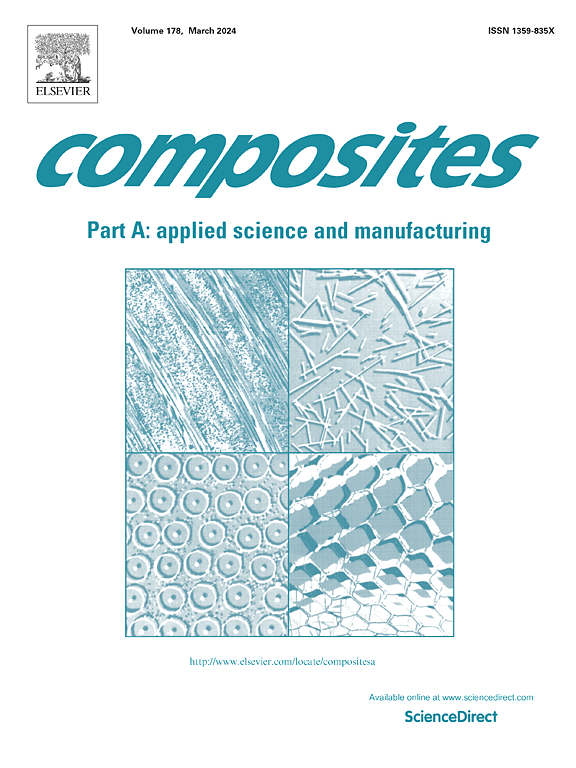Enhanced mechanical properties of CF/PEEK and CF/Epoxy composites with micro-/nano- Aramid Pulp interleaves
IF 8.1
2区 材料科学
Q1 ENGINEERING, MANUFACTURING
Composites Part A: Applied Science and Manufacturing
Pub Date : 2025-04-25
DOI:10.1016/j.compositesa.2025.108964
引用次数: 0
Abstract
Carbon fiber-reinforced polyetheretherketone (CF/PEEK) composites with excellent biomedical properties have been used clinically for bioimplants, but mechanical failure due to delamination remains a concern. This study explores the use of micro-/nano- Aramid Pulp (AP) fibers to enhance the delamination toughness of CF/PEEK composites. Furthermore, AP-interfacial toughened CF/PEEK composites are compared with common carbon fiber-reinforced epoxy (CF/Epoxy) composites. The findings revealed that AP toughening increased the compressive strength of CF/PEEK composites by 41%, improved flexural-after-impact (FAI) strength by 19%, and reduced the rear surface delamination area by 51 %. It was also found that the flexural failure of CF/PEEK composites is initiated from the tensile surface, in contrast to CF/Epoxy composites, which undergo initial delamination and micro-buckling in the compression region. Additionally, AP-interfacial toughening has effectively eliminated top surface compressive cracks in CF/PEEK composites under flexural conditions despite its tension-driven failure mechanism. Consequently, besides the comparison of CF/PEEK and CF/Epoxy composites, this study provides valuable insights into minimizing mechanical failures of CF/PEEK implants in patients, where delamination is a major contributing factor.
微/纳米芳纶浆料交织织物增强CF/PEEK和CF/环氧复合材料的力学性能
碳纤维增强聚醚醚酮(CF/PEEK)复合材料具有优异的生物医学性能,已被临床用于生物植入物,但由于分层引起的机械故障仍然是一个问题。本研究探讨了微/纳米芳纶浆(AP)纤维对CF/PEEK复合材料分层韧性的增强作用。并将ap界面增韧的CF/PEEK复合材料与普通碳纤维增强环氧树脂(CF/ epoxy)复合材料进行了比较。研究结果表明,AP增韧使CF/PEEK复合材料的抗压强度提高了41%,冲击后弯曲强度提高了19%,后表面分层面积减少了51%。研究还发现,CF/PEEK复合材料的弯曲破坏是从拉伸面开始的,而CF/环氧复合材料在压缩区经历了初始分层和微屈曲。此外,ap界面增韧有效地消除了CF/PEEK复合材料在弯曲条件下的顶表面压缩裂纹,尽管其破坏机制是拉伸驱动的。因此,除了CF/PEEK和CF/环氧树脂复合材料的比较外,本研究还为减少CF/PEEK植入物在患者中的机械故障提供了有价值的见解,其中分层是主要因素。
本文章由计算机程序翻译,如有差异,请以英文原文为准。
求助全文
约1分钟内获得全文
求助全文
来源期刊

Composites Part A: Applied Science and Manufacturing
工程技术-材料科学:复合
CiteScore
15.20
自引率
5.70%
发文量
492
审稿时长
30 days
期刊介绍:
Composites Part A: Applied Science and Manufacturing is a comprehensive journal that publishes original research papers, review articles, case studies, short communications, and letters covering various aspects of composite materials science and technology. This includes fibrous and particulate reinforcements in polymeric, metallic, and ceramic matrices, as well as 'natural' composites like wood and biological materials. The journal addresses topics such as properties, design, and manufacture of reinforcing fibers and particles, novel architectures and concepts, multifunctional composites, advancements in fabrication and processing, manufacturing science, process modeling, experimental mechanics, microstructural characterization, interfaces, prediction and measurement of mechanical, physical, and chemical behavior, and performance in service. Additionally, articles on economic and commercial aspects, design, and case studies are welcomed. All submissions undergo rigorous peer review to ensure they contribute significantly and innovatively, maintaining high standards for content and presentation. The editorial team aims to expedite the review process for prompt publication.
 求助内容:
求助内容: 应助结果提醒方式:
应助结果提醒方式:


